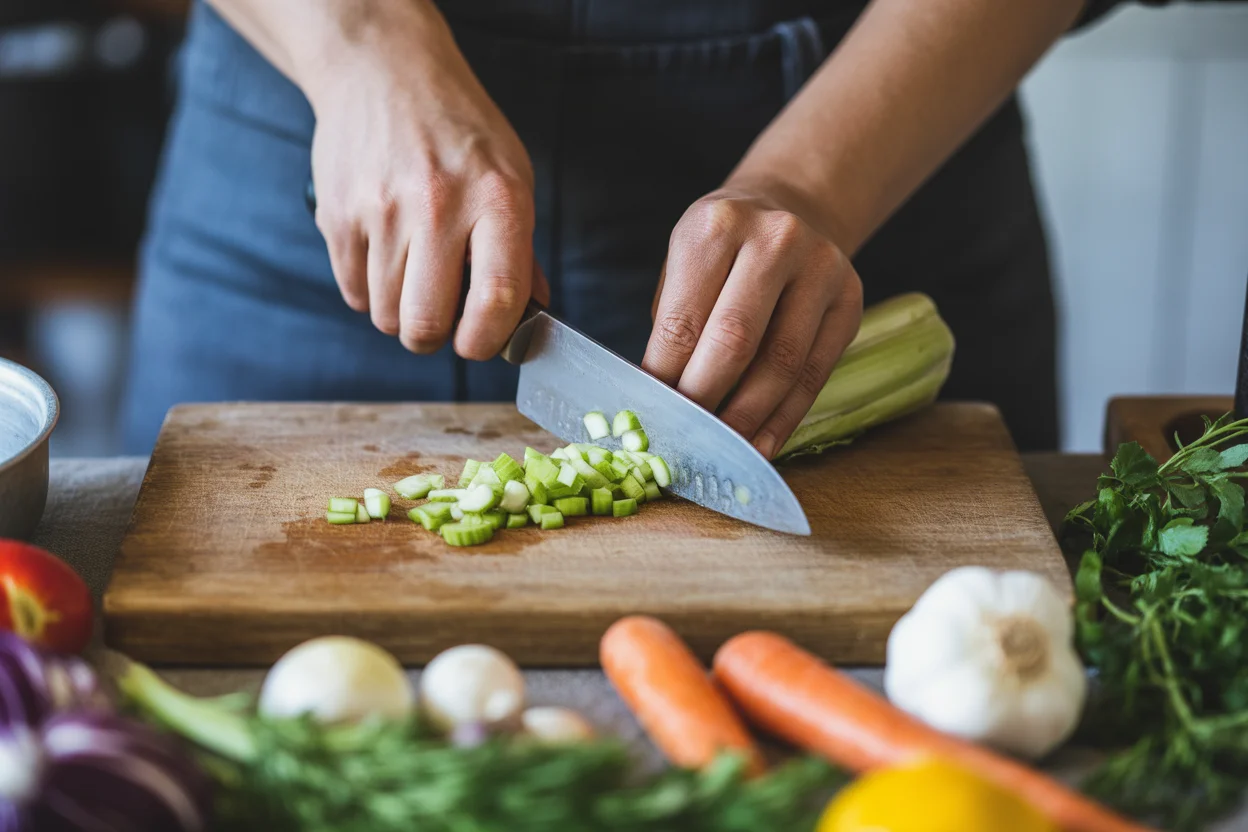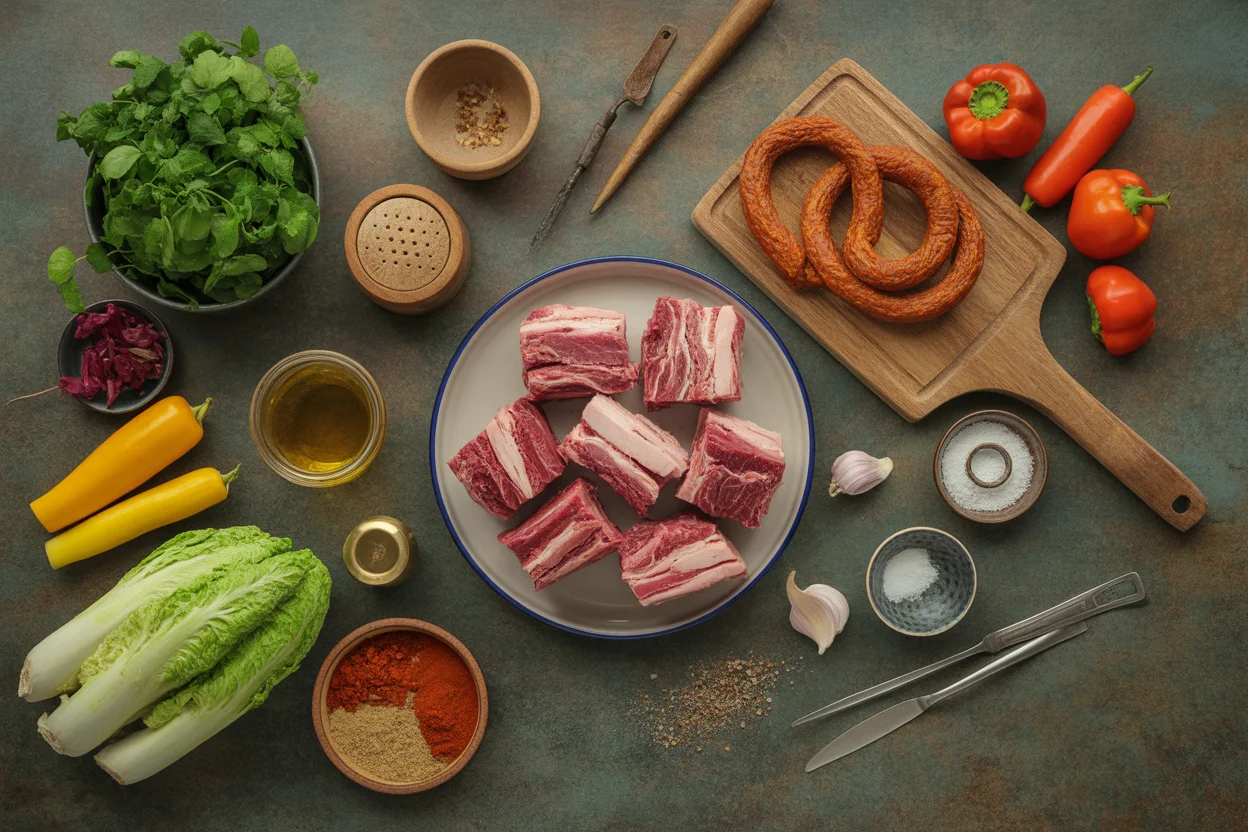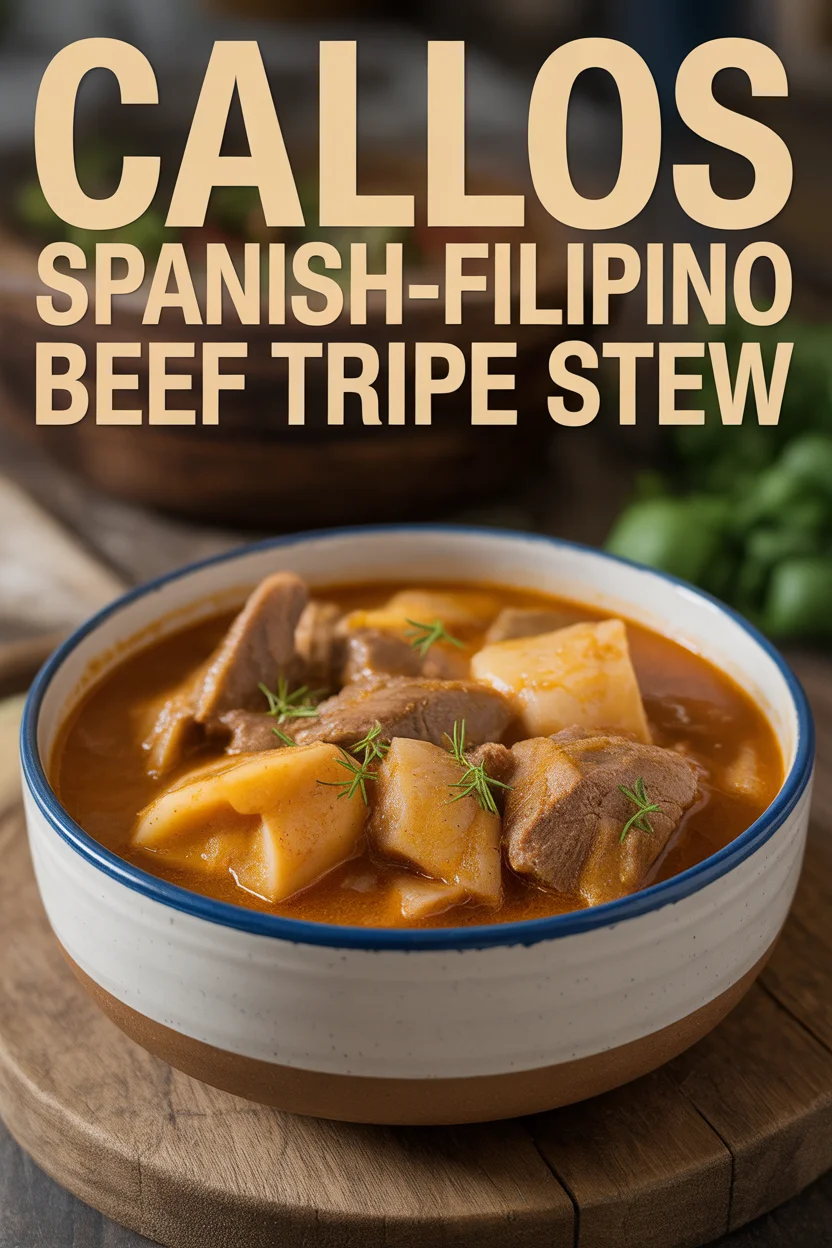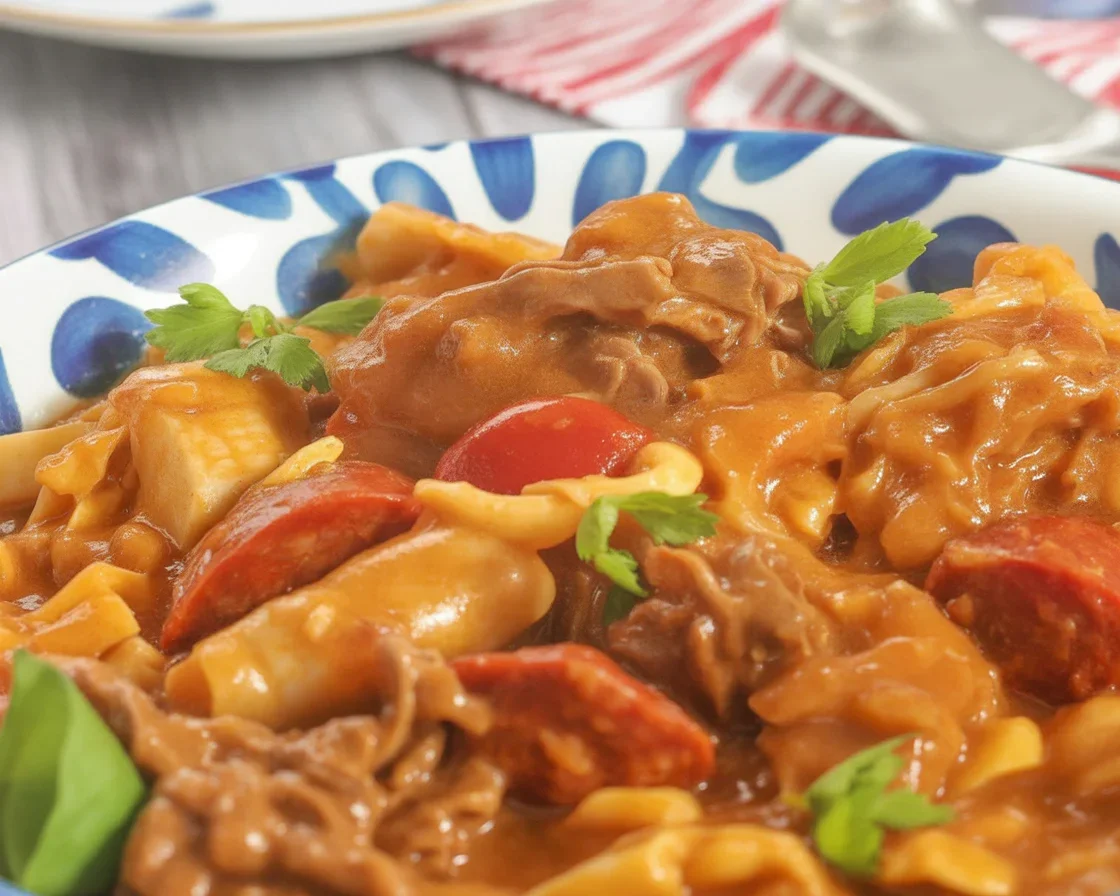Filipino callos is one of those dishes you hear about if you grew up in a Filipino or Spanish-influenced home. It’s the kind of beef tripe stew that shows up during special feasts, or when you want to impress your family with something totally different from regular adobo (yeah, you know what I’m saying!). Ever stood in front of your fridge thinking, “Ugh, what can I cook that’s both hearty and a little out-of-the-ordinary?” That’s where this stew hits the spot. Sure, there are other classic Filipino comfort foods like beef caldereta or that unforgettable goto, but nothing quite matches the aroma of callos slowly simmering. If you need more kid-friendly (and less adventurous) options for picky eaters, maybe check these out—but honestly, I say give callos a real shot. 
Overview of callos
Let’s chat about callos. If you’ve never heard of it, it’s a Spanish-Filipino stew made with beef tripe, chorizo, garbanzos, bell peppers, and all sorts of hearty goodness. The tomato sauce makes everything so rich you’ll probably be looking for extra rice to soak it up. Honestly, callos is not a quick meal. You need a little patience, but it’s so worth it—the kind of food that tastes better the next day (I swear!). People always freak out about the tripe, but listen, with the right prep it’s tender and soaks up flavor like nothing else. Also—fun fact—callos was one of those “special occasion only” dishes for our family, right after the lechon got demolished.
So, if you like food with history and bold, warm flavors, callos is a must-try. You kinda get the best of Spain and the Philippines in one bowl. Nothing too fancy, just really honest flavors coming together.
“I never thought I’d actually enjoy beef tripe, but after trying callos at a family party, I went back for seconds. The sauce is awesome and the chorizo seriously makes the dish complete!” – My Tita Vicky, the pickiest eater I know

Preparing beef tripe
Okay, let’s be real for a second. Prepping beef tripe is probably the weirdest part of this whole thing. If you don’t clean it well, your whole stew will taste off, like gym socks (yikes). First, wash it under cold water—a lot. No shame in being thorough. Then, boil it in water with a bit of vinegar and ginger for 15-20 minutes. This step knocks out any unpleasant smells and firms things up. After that, drain and rinse.
After that pre-cook, cut the tripe into bite-size pieces. Honestly, I like them small so my kids don’t give me side-eye at the table. People ask if you have to use tripe—yeah, it’s authentic, but if you really can’t, substitute with beef tendon or oxtail. It won’t be the same, but still tasty.
And hey, don’t throw in the tripe raw to save time or you’ll regret it. Trust me (made that mistake—once).

Cooking with tomato sauce
This is where everything gets nice and hearty. Start by sautéing some garlic and onions until they’re about borderline caramelized (not burned, unless you’re into that…). Then add chorizo and let it sizzle so it gets some crispy edges, releasing that punchy, smoky oil. Add the tripe and let it mingle with the chorizo for a few minutes. Pour in your tomato sauce and a splash of beef broth, scraping up all the browned bits from the bottom. That’s the flavor jackpot right there.
Let it simmer low and slow. Don’t rush this—seriously, good callos needs time. The tomato sauce thickens, the tripe softens, and everything melds. You want it rich, not watery; keep the lid just a little cracked so it reduces but doesn’t dry up. I usually taste and adjust salt halfway through.
The first time I got this right, it felt like I’d conquered Mount Everest (for real, I’m not kidding).
Adding vegetables
Now don’t skip this part! The veggies in callos keep everything fresh and lively. Garbanzos (chickpeas) are non-negotiable, in my opinion—they absorb so much flavor and give you those random bursts of nutty goodness. Toss them in about halfway through, since they’re usually pre-cooked.
Next, add in the bell peppers. I use red or green for color, plus a handful of green peas near the end. Some folks even throw in carrots or potatoes—totally up to your taste. The trick is not to overcook the vegetables. Nobody wants mushy bell pepper strings. Put the veggies in when you’ve got maybe 20 minutes left on your simmer, then taste. If you want to see more healthy Filipino recipes with plenty of veg, check this round-up.
Also, a quick warning: If you dump everything in at once, your veggies will turn bland and soggy. I’ve done it. Not fun.
Seasoning
Here’s where a little intuition goes a long way. I usually start with salt and cracked black pepper, then work in some smoked paprika (that, or Spanish sweet paprika—depends what’s in the cupboard). If the tomato sauce is really acidic, a tiny sprinkle of sugar balances things out. But sometimes I just live on the edge and dash in some hot sauce.
For a bold punch, toss in olives or capers. Some folks add fish sauce. Me? I just rely on the sausage for saltiness, but go wild. Taste as you go, and don’t be shy about tweaking until it makes your taste buds do a happy dance.
Want a little extra something? A few drops of lemon juice at the very end can freshen things up.

Serving hot
How you serve callos can totally make or break the experience. Here are my go-to moves:
- Spoon callos over a bed of white rice, and watch as everyone turns into rice monsters.
- Add a chunk of crusty bread for dipping and sopping up sauce.
- Top with a few fresh parsley leaves (if you’re feeling fancy).
- Serve callos in a big family bowl, let everyone dig in, and you’ll look like a five-star chef in your own kitchen.
I always save some for the next day—it tastes even better after all the flavors sit together overnight.
Historical influence
This is where callos gets cool (and a little nerdy if you love food history). Callos came to the Philippines through Spanish colonizers. Over the centuries, it’s gone from being a Madrid classic to a Filipino fiesta staple. Spanish callos uses mostly paprika, chickpeas, and blood sausage, but Filipino callos? Local tweaks, of course.
Filipino families added their own spins—think banana blossoms, sweet tomato sauce, whatever sausage happened to be around. You’ll see legit bistek tagalog at fiestas, but every household does callos a bit differently. What I love is that every spoonful feels like a history lesson crossed with comfort food.
I still remember my grandma telling me, “No two callos recipes are ever the same, and that’s exactly how it should be.” That’s tradition for you!
Wrapping Up
So, bottom line? Filipino callos is that perfect, old-school, crowd-pleasing dish for folks who want to serve up something unforgettable. Whether you’re just here for the tomato sauce or genuinely excited to try beef tripe, you get rich flavors, fun family time, and a little piece of culinary history. Ready to level up your home kitchen? Check out more at Callos – Kawaling Pinoy or this solid step-by-step at Easy Callos Recipe – Panlasang Pinoy. And if you’re curious how other home cooks are doing it, peek at this group chat on CALLOS MADRILENOS CALLLOS is one of the rare dishes in ….
Try it soon, and don’t be surprised if you start craving it the next cold day. Seriously, it’s that good.
Callos
Ingredients
Meat and Broth
- 2 pounds beef tripe Cleaned and cut into bite-size pieces
- 1 link chorizo Sliced
- 2 cups beef broth For added flavor
Vegetables
- 1 can garbanzos Drained
- 2 cups bell peppers Sliced, red or green
- 1 cup green peas Added in the last 20 minutes
Aromatics
- 3 cloves garlic Minced
- 1 medium onion Chopped
Sauce
- 2 cups tomato sauce Rich and thick
Seasonings
- 1 teaspoon salt
- 1 teaspoon cracked black pepper
- 1 teaspoon smoked paprika Or Spanish sweet paprika
- 1 teaspoon sugar To balance acidity if needed
- 1 tablespoon hot sauce Optional for added spice
Instructions
Preparation
- Clean the beef tripe thoroughly under cold water.
- Boil the tripe in water with a bit of vinegar and ginger for 15-20 minutes, then drain and rinse again.
- Cut the tripe into bite-size pieces.
Cooking
- Sauté minced garlic and chopped onions until they are golden.
- Add sliced chorizo to the pan and cook until crispy.
- Mix in the cleaned tripe, allowing it to absorb flavors for a few minutes.
- Pour in the tomato sauce and beef broth, scraping the browned bits from the pan.
- Simmer the mixture with the lid slightly ajar, checking occasionally for seasoning.
Adding Vegetables and Seasoning
- Add garbanzos when the stew is midway through cooking.
- Stir in the bell peppers and green peas 20 minutes before serving.
- Season to taste with salt, pepper, smoked paprika, and sugar.
Serving
- Serve callos over white rice with a sprinkle of parsley.
- Optionally, add crusty bread for dipping.

